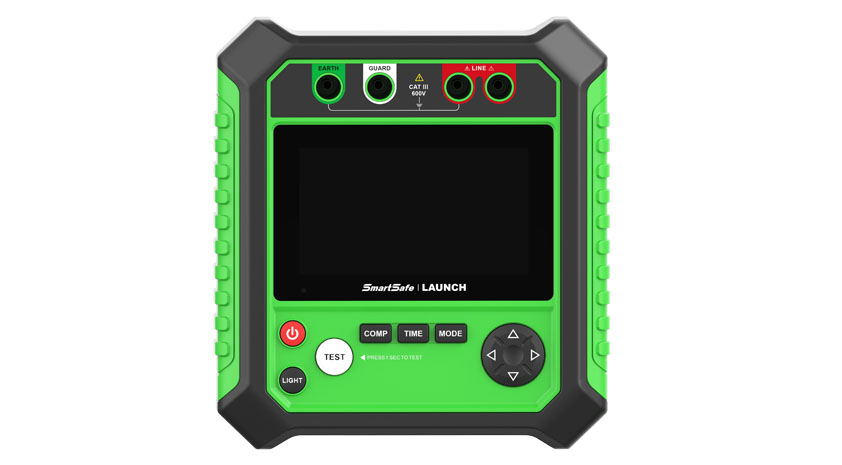Insulation tester, also known as megohmmeter, is an electrical instrument used to measure the insulation resistance of electrical components and systems. It is designed to assess the quality and integrity of insulating materials surrounding conductive parts.
Insulation testers are used in a wide variety of industries including electrical maintenance, manufacturing, construction and automotive repair. They are used to test various electrical equipment and systems such as cables, transformers, motors, generators, switchgear and electronic equipment. Its functions revolve around measuring and evaluating the insulation resistance of electrical components and systems, the following are the general functions provided by insulation testers:
1. Insulation resistance measurement: Its main function is to measure the insulation resistance of electrical insulators. It uses voltage and current to calculate resistance by applying a high DC voltage across an insulator and measuring the resulting current. This measurement helps determine the condition and effectiveness of the insulation.
2. Selectable test voltage: Many insulation testers allow users to select different test voltages according to the type and rating of the insulation being tested. Different insulating materials require specific test voltages to accurately evaluate their insulation resistance.
3. Resistance range: The insulation tester provides a wide range of resistance measurement functions to suit various insulation systems.
4. Polarization Index (PI) and Dielectric Absorption Ratio (DAR): Some insulation testers provide additional functions, such as PI and DAR measurements. The polarization index indicates an insulator's ability to recover after a high-voltage stress test, while the dielectric absorption ratio measures an insulator's ability to hold an electrical charge over time.
5. Automatic discharge: Insulation testers usually have an automatic discharge function, which can safely discharge the residual voltage in the device or system under test after the insulation resistance measurement is completed.
These capabilities allow technicians to assess the condition of electrical insulation, identify potential faults or weaknesses, ensure compliance with safety standards, and perform preventive maintenance on electrical systems and equipment. Regular insulation testing is essential for preventive maintenance, troubleshooting and ensuring the safety and reliability of electrical systems.

An insulation tester works by applying a high DC voltage across the insulation of an electrical component or system and measuring the resulting current. Here is a step-by-step overview of how an insulation tester works:
1. Voltage application: Insulation testers generate high DC voltages, typically ranging from a few hundred volts to thousands of volts, depending on the insulation being tested. A voltage is applied across the insulator under test.
2. Insulation resistance measurement: When a high voltage is applied, a small current flows through the insulating material. Insulation testers use sensitive internal circuitry to accurately measure this current.
3. Ohm's law calculation: The insulation tester uses Ohm's law to calculate the insulation resistance. By measuring the current and knowing the applied voltage, the tester can determine insulation resistance.
4. Display and readout: The insulation tester provides a digital display or readout that shows the measured insulation resistance in megohms (MΩ) or gigaohms (GΩ). This value indicates the quality and condition of the insulation.
5. Discharge of capacitive load: After the insulation resistance measurement is completed, some insulation testers have an automatic discharge function. It safely discharges any residual voltage that may exist in capacitive loads, ensuring the safety of technicians and preventing potential electric shock.
By performing insulation resistance measurements, insulation testers help identify any insulation weakness, degradation, contamination, or moisture ingress that could compromise the safety, performance, or reliability of electrical systems.
These two are often used interchangeably, and they both refer to measuring insulation resistance with an insulation tester or megohmmeter. However, there is a slight difference between the two:
Insulation Testing: The term "insulation testing" is a broad and general reference to the process of measuring insulation resistance. It involves measuring the insulation resistance of various electrical components and systems using any suitable insulation tester, including a megohmmeter.
Megger Testing: The term "megger testing" refers specifically to insulation resistance testing using a brand of insulation tester called a megohmmeter. The term "megger test" has become synonymous with insulation resistance testing, especially when it comes to the use of megger instruments.
With the advancement of technology, there are various insulation testers on the market for various functions. SmartSafe has launched an insulation tester specifically for electric vehicles.
iSmartEV RT100 insulation tester comes equipped with robust measurement and data processing software, enabling it to efficiently conduct measurements of insulation resistance, voltage, and various other parameters. With its dependable performance and user-friendly operation, it is an ideal choice for field measurement and maintenance professionals working with power equipment and power supply lines.
Return